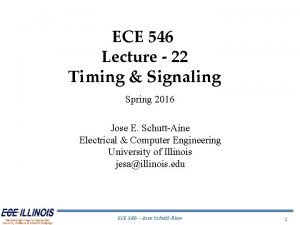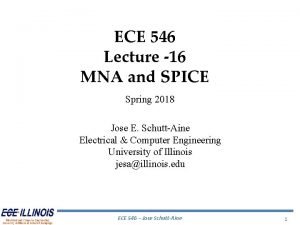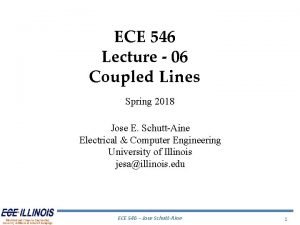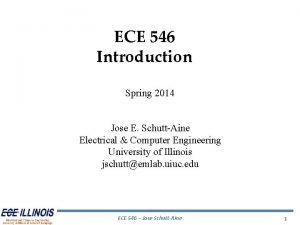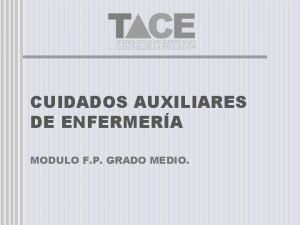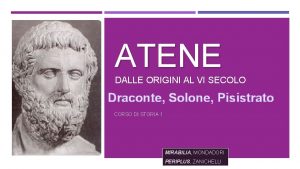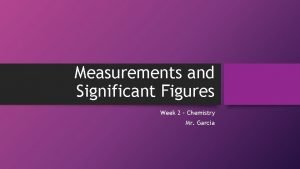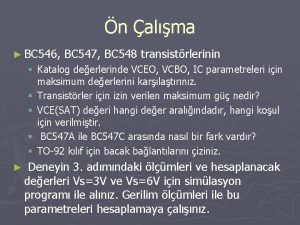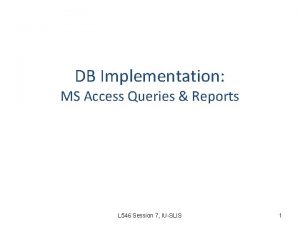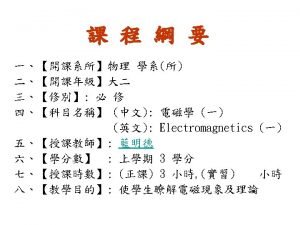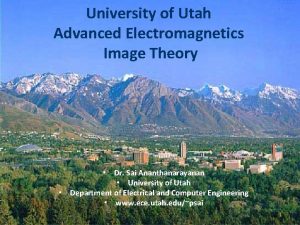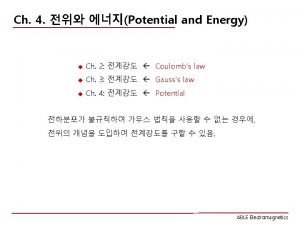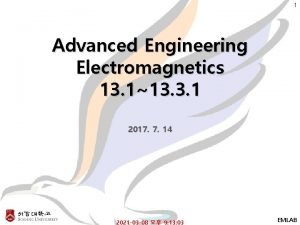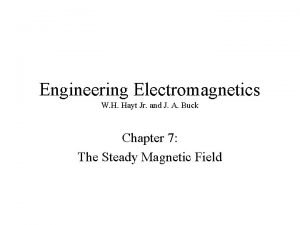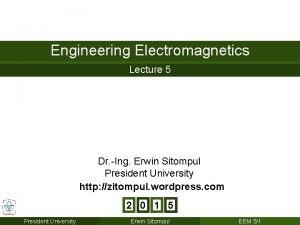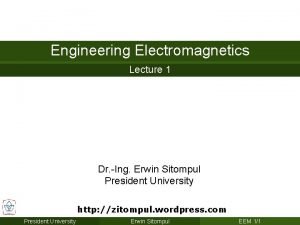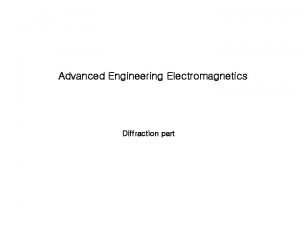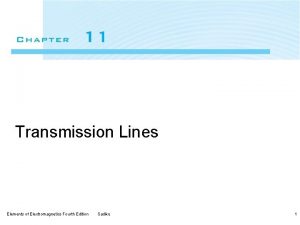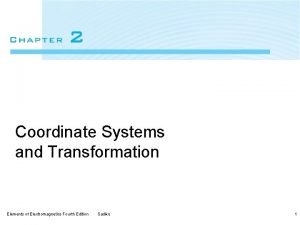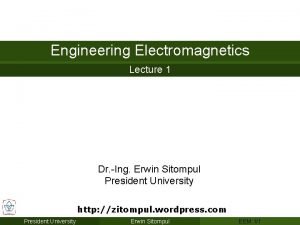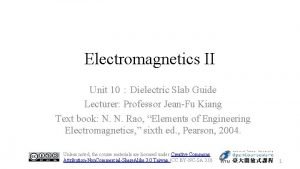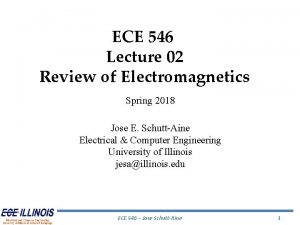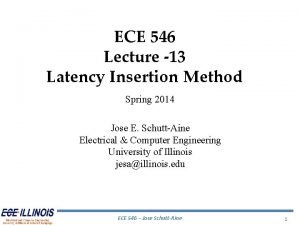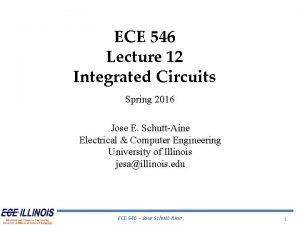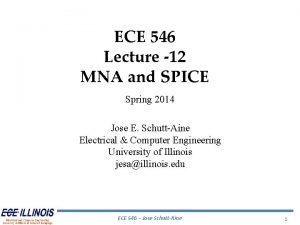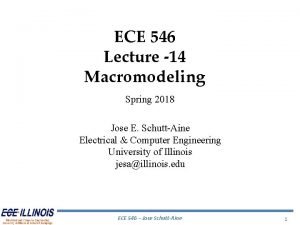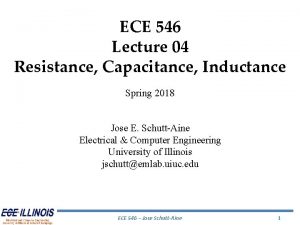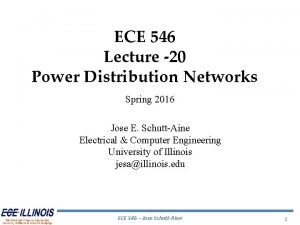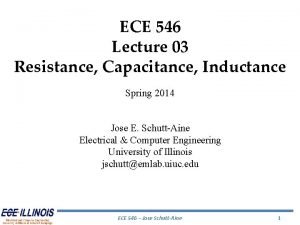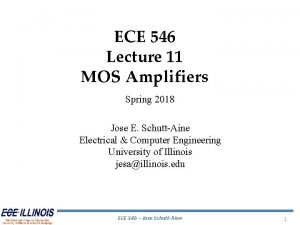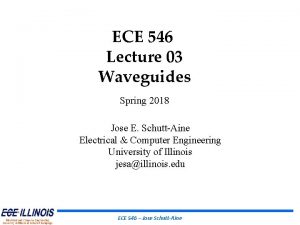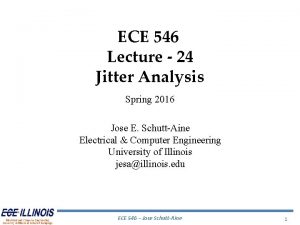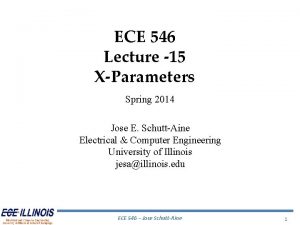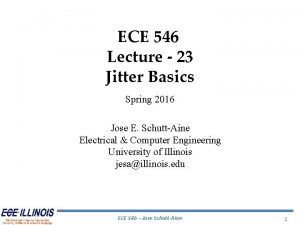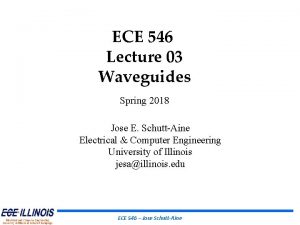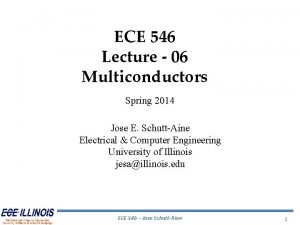ECE 546 Lecture 02 Review of Electromagnetics Spring










































- Slides: 42

ECE 546 Lecture 02 Review of Electromagnetics Spring 2014 Jose E. Schutt-Aine Electrical & Computer Engineering University of Illinois jschutt@emlab. uiuc. edu ECE 546 – Jose Schutt-Aine 1

Electromagnetic Quantities Electric field (Volts/m) Electric flux density (Coulombs/m 2) Magnetic field (Amperes/m) Magnetic flux density (Webers/m 2) Current density (Amperes/m 2) Charge density (Coulombs/m 2) ECE 546 – Jose Schutt-Aine 2

Maxwell’s Equations Faraday’s Law of Induction Ampère’s Law Gauss’ Law for electric field Gauss’ Law for magnetic field ECE 546 – Jose Schutt-Aine 3

Constitutive Relations Permittivity e: Farads/m Permeability m: Henries/m Free Space ECE 546 – Jose Schutt-Aine 4

Continuity Equation ECE 546 – Jose Schutt-Aine 5

Electrostatics Assume no time dependence Poisson’s Equation if no charge is present Laplace’s Equation ECE 546 – Jose Schutt-Aine 6

Integral Form of ME ECE 546 – Jose Schutt-Aine 7

Boundary Conditions ECE 546 – Jose Schutt-Aine 8

Free Space Solution Faraday’s Law of Induction Ampère’s Law Gauss’ Law for electric field Gauss’ Law for magnetic field ECE 546 – Jose Schutt-Aine 9

Wave Equation can show that ECE 546 – Jose Schutt-Aine 10

Wave Equation separating the components ECE 546 – Jose Schutt-Aine 11

Wave Equation Plane Wave (a) Assume that only Ex exists Ey=Ez=0 (b) Only z spatial dependence This situation leads to the plane wave solution In addition, assume a time-harmonic dependence then ECE 546 – Jose Schutt-Aine 12

Plane Wave Solution solution where propagation constant In the time domain solution ECE 546 – Jose Schutt-Aine 13

Plane Wave Characteristics where propagation constant In free space ECE 546 – Jose Schutt-Aine 14

Solution for Magnetic Field If we assume that then intrinsic impedance of medium ECE 546 – Jose Schutt-Aine 15

Time-Average Poynting Vector Poynting vector W/m 2 time-average Poynting vector W/m 2 We can show that ECE 546 – Jose Schutt-Aine 16

Material Medium or s: conductivity of material medium (W-1 m-1) since then ECE 546 – Jose Schutt-Aine 17

Wave in Material Medium g is complex propagation constant a: associated with attenuation of wave b: associated with propagation of wave ECE 546 – Jose Schutt-Aine 18

Wave in Material Medium Solution: decaying exponential Complex intrinsic impedance Magnetic field ECE 546 – Jose Schutt-Aine 19

Wave in Material Medium Phase Velocity: Wavelength: Special Cases 1. Perfect dielectric air, free space and ECE 546 – Jose Schutt-Aine 20

Wave in Material Medium 2. Lossy dielectric Loss tangent: ECE 546 – Jose Schutt-Aine 21

Wave in Material Medium 3. Good conductors Loss tangent: ECE 546 – Jose Schutt-Aine 22

Material Medium a attenuation PEC b propagation - h dp H, E Examples 0 0 0 supercond copper Good conductor finite Poor conductor Perfect dielectric Ice finite air 0 finite ECE 546 – Jose Schutt-Aine 23

Radiation - Vector Potential Assume time harmonicity ~ (1) (2) (3) (4) ECE 546 – Jose Schutt-Aine 24

Radiation - Vector Potential Using the property: : vector potential ECE 546 – Jose Schutt-Aine 25

Vector Potential Since a vector is uniquely defined by its curl and its divergence, we can choose the divergence of A Lorentz condition 26 ECE 546 – Jose Schutt-Aine 26

Vector Potential D’Alembert’s equation 27 ECE 546 – Jose Schutt-Aine 27

Vector Potential Three-dimensional free-space Green’s function Vector potential From A, get E and H using Maxwell’s equations 28 ECE 546 – Jose Schutt-Aine 28

Vector Potential For infinitesimal antenna, the current density is: Calculating the vector potential, In spherical coordinates, 29 ECE 546 – Jose Schutt-Aine 29

Vector Potential Resolving into components, 30 ECE 546 – Jose Schutt-Aine 30

E and H Fields Calculate E and H fields 31 ECE 546 – Jose Schutt-Aine 31

E and H Fields 32 ECE 546 – Jose Schutt-Aine 32

E and H Fields 33 ECE 546 – Jose Schutt-Aine 33

E and H Fields 34 ECE 546 – Jose Schutt-Aine 34

Far Field Approximation Note that: ECE 546 – Jose Schutt-Aine 35

Far Field Approximation Characteristics of plane waves • • Uniform constant phase locus is a plane Constant magnitude Independent of q Does not decay Similarities between infinitesimal antenna far field radiated and plane wave (a) E and H are perpendicular (b) E and H are related by h (c) E is perpendicular to H ECE 546 – Jose Schutt-Aine 36

Poynting Vector Time-average Poynting vector or TA power density E and H here are PHASORS ECE 546 – Jose Schutt-Aine 37

Time-Average Power Total power radiated (time-average) ECE 546 – Jose Schutt-Aine 38

Time-Average Power ECE 546 – Jose Schutt-Aine 39

Directivity For infinitesimal antenna, ECE 546 – Jose Schutt-Aine 40

Directivity: gain in direction of maximum value Radiation resistance: From we have: For infinitesimal antenna: ECE 546 – Jose Schutt-Aine 41

Radiation Resistance For free space, (for Hertzian dipole) The radiation resistance of an antenna is the value of a fictitious resistance that would dissipate an amount of power equal to the radiated power Pr when the current in the resistance is equal to the maximum current along the antenna A high radiation resistance is a desirable property for an antenna ECE 546 – Jose Schutt-Aine 42
 Ece 546
Ece 546 Ece546
Ece546 Ece546
Ece546 Jose schutt-aine
Jose schutt-aine Rd 546/95
Rd 546/95 546-528 a.c
546-528 a.c Significant figures of 546 km
Significant figures of 546 km Bc 547
Bc 547 L 546
L 546 Cheng field and wave electromagnetics
Cheng field and wave electromagnetics Image theory electromagnetics
Image theory electromagnetics Able electromagnetics
Able electromagnetics Electromagnetics
Electromagnetics Advanced engineering electromagnetics
Advanced engineering electromagnetics Intensity of magnetic field
Intensity of magnetic field Engineering electromagnetics
Engineering electromagnetics Engineering electromagnetics
Engineering electromagnetics Engineering electromagnetics
Engineering electromagnetics Able electromagnetics
Able electromagnetics Sadiku
Sadiku Electromagnetics
Electromagnetics Electromagnetics
Electromagnetics Electromagnetics
Electromagnetics 01:640:244 lecture notes - lecture 15: plat, idah, farad
01:640:244 lecture notes - lecture 15: plat, idah, farad Spring summer fall winter and spring cast
Spring summer fall winter and spring cast Summer winter fall spring
Summer winter fall spring World history spring final exam review answers
World history spring final exam review answers World geography spring final review
World geography spring final review Chapter review motion part a vocabulary review answer key
Chapter review motion part a vocabulary review answer key Ap gov final review
Ap gov final review Nader amin-salehi
Nader amin-salehi Systematic review definition
Systematic review definition Narrative review vs systematic review
Narrative review vs systematic review Project procurement management lecture notes
Project procurement management lecture notes Lecture about sport
Lecture about sport Lecture on healthy lifestyle
Lecture on healthy lifestyle Meaning of this
Meaning of this Life lecture meaning
Life lecture meaning Randy pausch last lecture summary
Randy pausch last lecture summary Tensorflow lecture
Tensorflow lecture Theology proper lecture notes
Theology proper lecture notes Strategic management lecture
Strategic management lecture Geology lecture series
Geology lecture series
